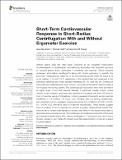Short-Term Cardiovascular Response to Short-Radius Centrifugation With and Without Ergometer Exercise
Author(s)
Diaz-Artiles, Ana; Heldt, Thomas; Young, Laurence Retman
DownloadPublished version (5.670Mb)
Terms of use
Metadata
Show full item recordAbstract
Artificial gravity (AG) has often been proposed as an integrated multisystem countermeasure to physiological deconditioning associated with extended exposure to reduced gravity levels, particularly if combined with exercise. Twelve subjects underwent short-radius centrifugation along with bicycle ergometry to quantify the short-term cardiovascular response to AG and exercise across three AG levels (0 G or no rotation, 1 G, and 1.4 G; referenced to the subject's feet and measured in the centripetal direction) and three exercise intensities (25, 50, and 100 W). Continuous cardiovascular measurements were collected during the centrifugation sessions using a non-invasive monitoring system. The cardiovascular responses were more prominent at higher levels of AG and exercise intensity. In particular, cardiac output, stroke volume, pulse pressure, and heart rate significantly increased with both AG level (in most of exercise group combinations, showing averaged increments across exercise conditions of 1.4 L/min/g, 7.6 mL/g, 5.22 mmHg/g, and 2.0 bpm/g, respectively), and workload intensity (averaged increments across AG conditions of 0.09 L/min/W, 0.17 mL/W, 0.22 mmHg/W, and 0.74 bpm/W respectively). These results suggest that the addition of AG to exercise can provide a greater cardiovascular benefit than exercise alone. Hierarchical regression models were fitted to the experimental data to determine dose-response curves of all cardiovascular variables as a function of AG-level and exercise intensity during short-radius centrifugation. These results can inform future studies, decisions, and trade-offs toward potential implementation of AG as a space countermeasure.
Date issued
2018-11Department
Massachusetts Institute of Technology. Institute for Medical Engineering & Science; Massachusetts Institute of Technology. Department of Electrical Engineering and Computer Science; Massachusetts Institute of Technology. Department of Aeronautics and AstronauticsJournal
Frontiers in Physiology
Publisher
Frontiers Media SA
Citation
Diaz-Artiles, Ana et al. "Short-Term Cardiovascular Response to Short-Radius Centrifugation With and Without Ergometer Exercise." Frontiers in Physiology 9 (November 2018): 1492 © 2018 Diaz-Artiles
Version: Final published version
ISSN
1664-042X